|
Even
if
you
haven’t
read
Tolstoy’s
voluminous
novel
you
are
probably
familiar
with
the
story:
the
beautiful
Anna
Karenina
has
a
passionate
affair
with
a
young
officer
and
can’t
get
a
divorce.
Faced
with
the
loss
of
her
child
and
the
social
disgrace,
she
throws
herself
under
a
train.
The
story
has
intricate
sub-plots
and
innumerable
characters,
but
that
hasn’t
deterred
a
number
of
choreographers
from
turning
it
into
ballet.
The
latest
rendition
is
by
Yuri
Possokhov,
the
Ukrainian-born,
Bolshoi-trained
choreographer
in
residence
at
San
Francisco
Ballet.
Possokhov’s
creations
have
been
hit
or
miss.
There
have
been
masterpieces–like
his
2015 Swimmer, or works full of originality and daring like Stravinsky’s Violin
Concert last year (both reviewed in these pages). His Anna Karenina won an international choreography award and got rave reviews but is vastly over-rated in my view.
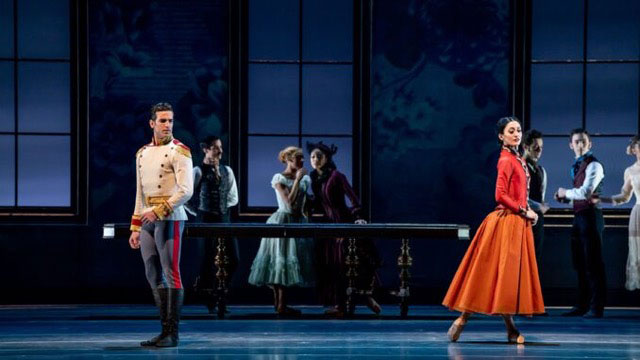
The work was commissioned by the Joffrey Ballet in 2019. Because of
pandemic delays it came to the SF Bay Area only now, presented by Cal
Performances in Berkeley. Possokhov obtained a score from a Russian
friend, 35 yea-old Ilya Demutsky, and problems with this score (played by
the Berkeley Symphonic Orchestra under Scott Speck) showed up already
in the prologue. A minimal train platform with a few travelers is veiled in
steam clouds. Upfront, a mechanic dances frenetically to an orchestration
so bombastic that one could imagine Russia’s great wars were to come next.
But all that comes is a little stumble as the mechanic lands on the rails, a
mere foot below the platform. No train appears. Anna and her future lover,
Count Vronsky, are dimly seen watching the fatal accident. They also look
at each other, but no emotion emanates from the music-swollen scene. In
the novel, the metallic clanking of the mechanic’s hammer haunts Anna to
her last day–a sound I hoped to hear in the score (as a Wagnerian leitmotif,
perhaps), but I didn’t detect it. This discrepancy of over-emphatic music
and a flat scenic outcome right at the start occurs throughout much of the
evening.
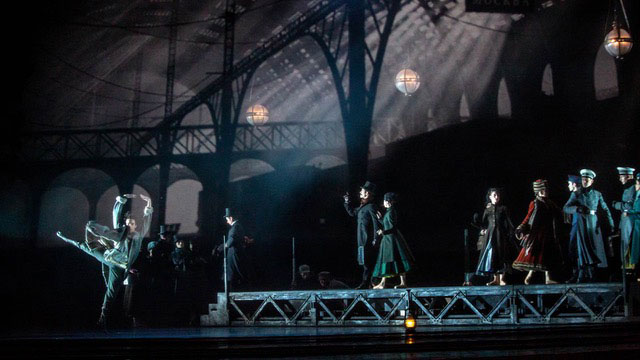
That said, there is some grand spectacle in the video-dominated sets and
lavish period costumes, the excellent dancers of the Joffrey Ballet, and the
operatic addition of a mezzo soprano (Lindsay Metzger) who sings every
now and then in Russian. Might she be reading from Tolstoy’s novel? If
there were no better examples of Anna Karenina ballets one might say,
okay, it’s a start and one will have to wait for better things to come.
Unfortunately, the better things have come already: in 1972, a stage and
film version by the great Russian ballerina Maya Plissetskaya, and in 2011,
Russian expat Alexei Ratmansky’s version for the Mariinsky Ballet
(formerly the Kirov). Plissetskaya and Ratmansky both chose the same
music: a shorter symphonic composition by Rodion Shchedrin that is more
subtly attuned to the psychology of Tolstoy’s characters: both ballets focus
on the contradictory impulses and obsessions of the protagonists. Both
works can be watched on YouTube. Possokhov, by contrast, caters to big,
simplistic certitudes: stiff husband, unsatisfied wife, ardent young lover –
all awash in “irresistible passion.”
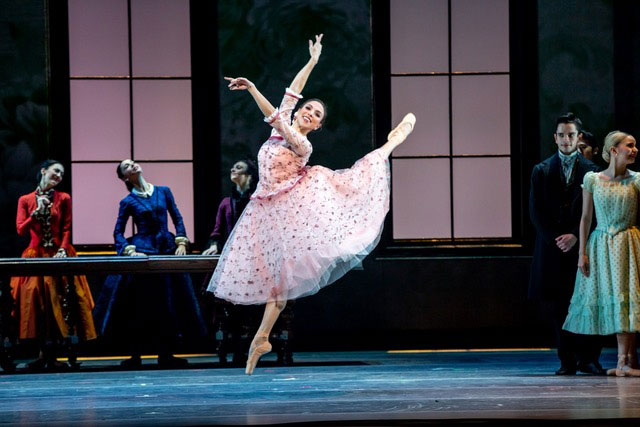
The first grand scene is the ball where Vronsky (Alberto Velasquez)
abandons young princess Kitty who is in love with him. Kitty (Yumi
Kanazawa) has rejected her suitor Levin (Hyuma Kiyozawa) for Vronsky,
but Vronsky gets infatuated with Anna (Victoria Jaiani). An unappealing
waltz lumbers on, spinning a number of couples around and around in
conventional movements. The ballroom is gloomy. The ball gowns are
greyish-dark. Even the debutante Kitty is clad in (light) grey. Lost is the big
splash Anna makes in the novel because she appears in the midst of the
ballroom glitter in sumptuous black.
Fortunately, the superb Georgian dancer Victoria Jaiani makes sure Anna
stands out in the gloom with her pronounced sensuality and languor.
Vronsky is dashing, Anna is flattered, Kitty is devastated. The whole scene
should have lasted a few minutes to render its promise, but by now we are
almost half an hour in, growing antsy with waltzing.
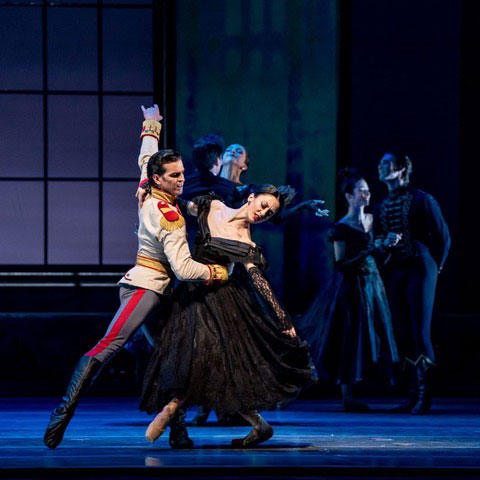
Next, the most alluring visual scenes of the book is oddly left out: the night
train, when Anna and Vronsky meet accidentally on a platform in the
falling snow and admit their attraction. It’s a loss, but Possokhov adds a
convincing solo of longing for Vronsky while a movie-star portrait of Anna
is projected on a scrim. I liked the idea of giving the infatuated lover a
larger role–and the fine, athletic Alberto Velasquez does the role justice.
Vronsky’s character, however, is not extended to his more contradictory
traits. Particularly in the following scene of the racecourse, there is no hint
that he gambles away a sure victory through his grandiosity and
negligence.
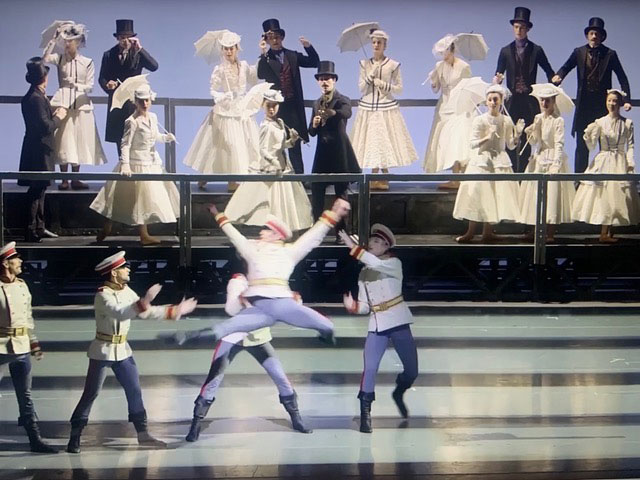
Anna, her husband and members of the aristocracy watch from the tribune
as a group of officers mime a melee of riders–a divertissement with a touch
of male gymnastics. Vronsky falls – another undramatic stumble while the
music swells . The drama is only indicated by a hysterical reaction from
Anna that vastly overplays her indiscretion in the novel. Anna is finally
dragged away by Karenin, there is a pistol shot, and we are left with the
huge projection of the wild eye of a horse.
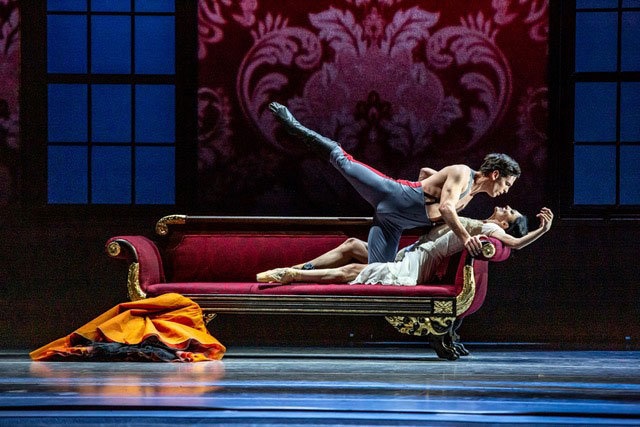
One of the convincing scenes is the consummation of Anna and Vronsky’s
passion in his rooms. Here Possokhov shows his talent, giving youth and
inventive sensuality to the couple. Vronsky is like an infatuated boy
adoring more than possessing; Anna is like a lithe nymph with exquisite,
romantically abandoned arms. When she leaves, pulling her dress behind
her, he throws himself to the floor and touches the flounces of her skirt
with a last kiss.
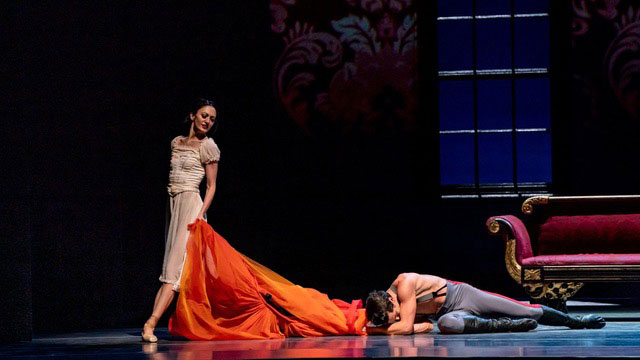
Another inspired scene is Anna on her sickbed in a morphine vision. She
imagines her husband Karenin ( the compelling Dylan Guttierez) and
Vronsky sharing her love equally. The two men pass her tenderly back and
forth in surprising, beguiling moves and let her fly from one pair of arms to
the other. It’s a dreamlike, emotional scene, and for once the music holds
back with a gentle piano passage.
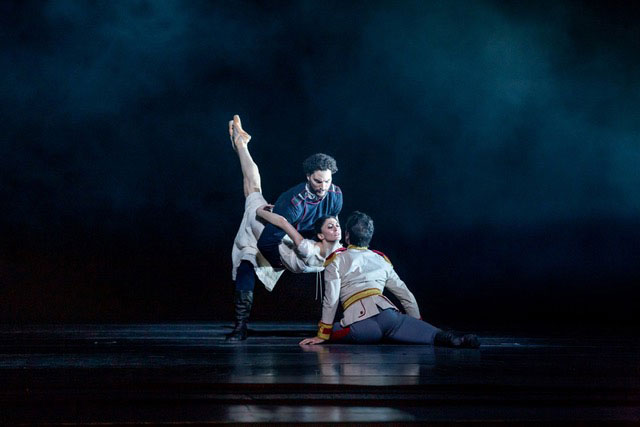
Possokhov shows Karenin in a government session where he stiffly stalks
around gesticulating. Nothing relevant is added to the story with this scene
while another essential scene in the drama is missing: Anna’s night at the
opera, where she appears in grand attire and is snubbed by everyone.
Psychologically, this humiliation is the turning point. After losing the right
to see her son, Anna realizes that she alone, not Vronsky, is expelled from
society and has no way out. Possokhov doesn’t show her anger and jealous
distrust of Vronsky. He gives her a solo of lonely despair, and the next
moment, she is on the train tracks.
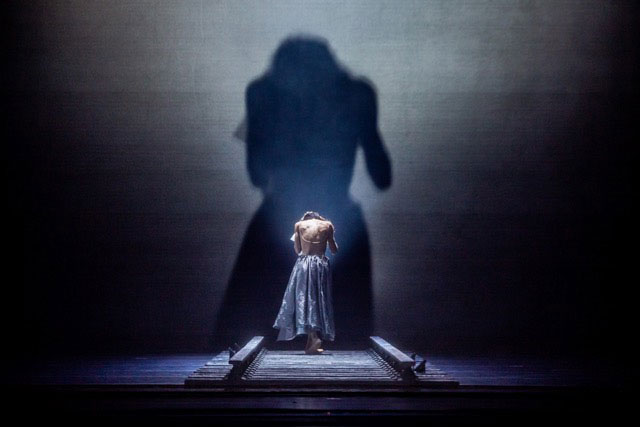
Now a couple of disturbing things happen.
First, at the train station, Anna walks toward a blinding light
backstage—the oncoming train—and we see her silhouette on the frontal
scrim getting bigger and bigger the closer she gets to the locomotive–a
visually effective move. But then the huge shadow-figure of Anna suddenly
strips off her clothes. Hold on! Anna Karenina, a member of the aristocracy
in 19th century St. Petersburg, goes naked before throwing herself on the
rails? Is it sensationalism? Is Tolstoy’s tragic ending of the story not enough
? Does Anna Karenina need another, final humiliation inflicted by the
choreographer?
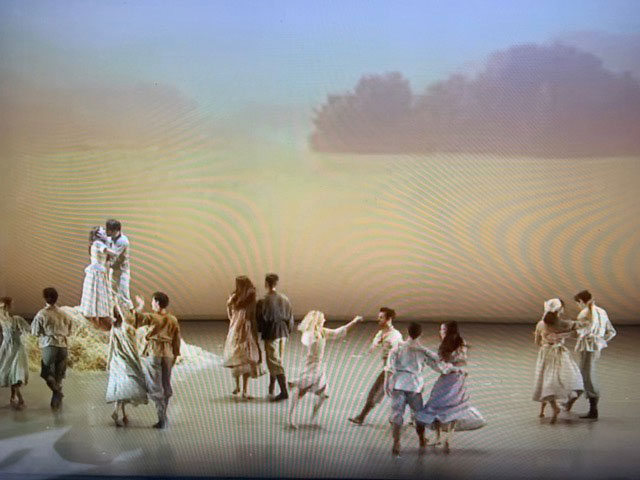
Not enough with this bizarre twist: Possokhov doesn’t stop with Anna’s
death. The stage lights up, we see a blurry field of wheat, and now Kitty,
who has finally accepted her country husband Levin, dances a pas de deux
of happy coupledom, soon joined by six merry peasant couples cavorting in
the sun. The mezzo soprano sings a Russian folk song in disjoint harmonies
(not exactly rousing), but the frolics around a pile of hay go on… and on.
Finally, huge drapes of greenish silk come down and covers the whole
stage. Levin, who is a main character in the novel but hardly appears in the
ballet, has the last word, so to speak: danced by Hyuma Kiyozawa, he
fondly caresses the drapes before vanishing behind them. The program
notes explain: “He finds contentment in understanding the purpose of his
life.”
Surely, this epilog is meant to be Tolstoy’s vision of social harmony rooted
in mother Russia’s soil, but it comes across as kitschy socialist realism and
even awakens uncomfortable associations with propaganda for the Russia
of today. Possokhov is not known for making long words about his work, so
it is left to anyone’s guess what to make of the muddle.
Photos by Cheryl Mann
|